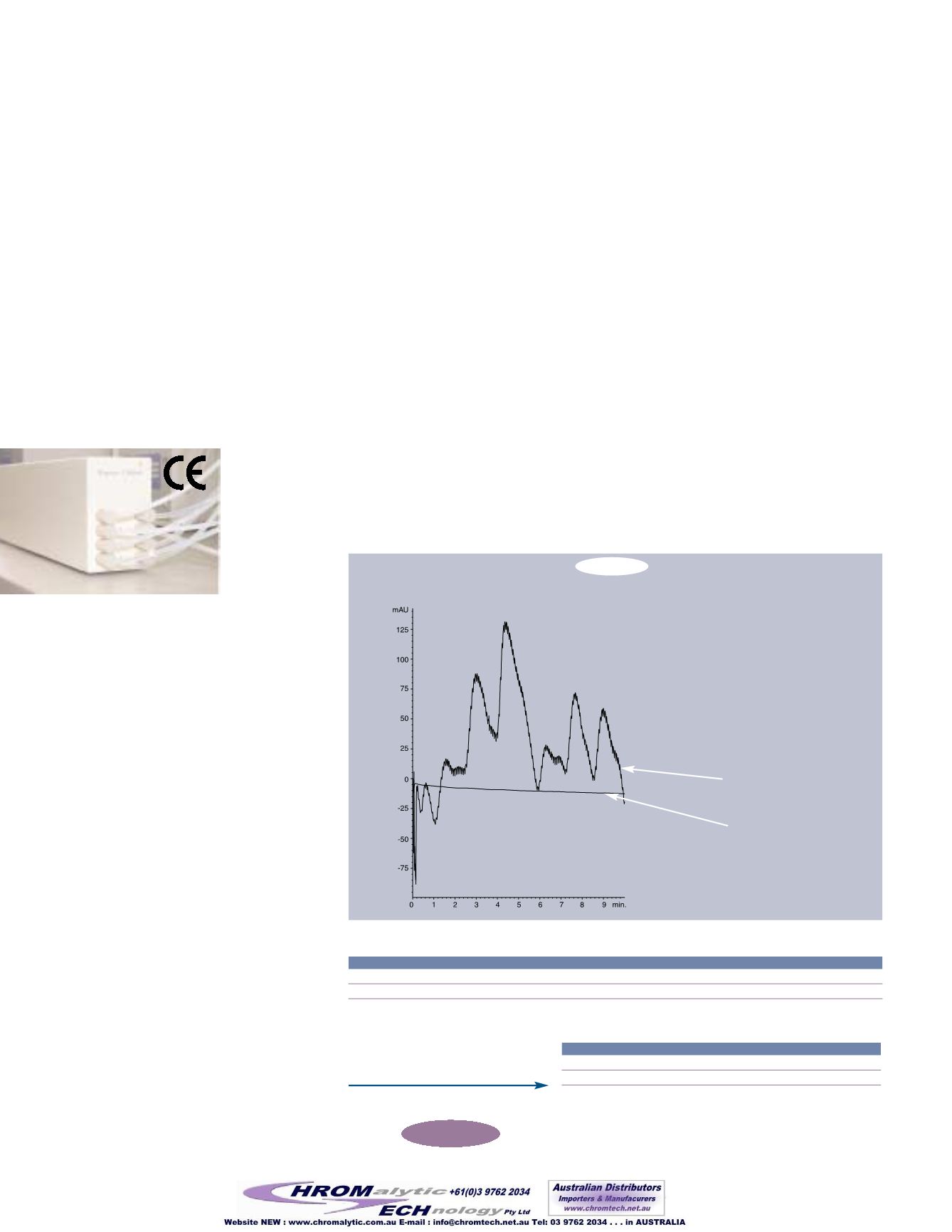

• 4 •
www.restekcorp.com800-356-1688
Dissolved gases in mobile phases can be the source
of several common HPLC system problems, such as
pump flow rate instability and irreproducible gradi-
ents. Out-gassing from the mobile phases can
result in air bubbles in the check valves, observed
as cavitations
or pressure
fluctuations in
the pump
(remember
gases are com-
pressible while
liquids are
not). Air bub-
bles also may
form within the
detector flow cell leading to spikes in the resulting
chromatogram. Gases that remain dissolved in the
mobile phase can have a quenching effect when
using fluorescence detectors and can cause
increased background noise in UV-visible detectors.
This can result in lowered sensitivity. Therefore, in
order to optimize system performance, mobile
phases should be degassed prior to entering the
HPLC pumps.
Some of the traditional degassing techniques
include sonication with off-line vacuum degassing
or helium sparging. Each has varying degrees of
effectiveness, but neither approaches the level of
gas removal efficiency achieved through the use of
an in-line vacuum degasser.
Sonication in conjunction with off-line vacuum
degassing helps reduce the presence of dissolved
gases. But there is the possibility that gases can
redissolve into the mobile phase over time because,
once degassing is complete, the mobile phase is
reexposed to the atmosphere. Helium sparging also
is useful at removing dissolved gases. One benefit
over sonication/vacuum is that you can prevent
gases from redissolving by maintaining a helium
blanket over the mobile phase after sparging. A
drawback to helium sparging is dealing with bulky
gas tank cylinders in the lab. You must use chro-
matographic-grade helium so that the mobile phase
is not contaminated, which can be an expensive
proposition if used routinely.
Bubble Trouble in Your HPLC
Mobile Phase?
Degasys In-Line Mobile Phase Degasser
✔
Prevents out-gassing to improve flow rate stability and reduce
baseline noise.
✔
Quick equilibration and changeover of mobile phase solvents.
✔
Less solvent waste due to low internal volume (400µL).
In-line vacuum degassers minimize these problems.
Restek now carries an in-line degasser that offers
several advantages over other manufacturers—the
Degasys in-line mobile phase degasser. These units
are more effective at removing dissolved gases than
either vacuum/sonication or helium sparging
(Figure 1), and because the mobile phase is being
degassed just prior to entering the HPLC system there
is significantly less opportunity for gases to redissolve
in the mobile phase. In addition, the units are easy to
install and take up very little bench-top space.
In-line degassers work by passing the mobile phase
through a length of tubing made of a semi-perme-
able material, traditionally this has been PTFE. The
tubing is encased in a vacuum chamber and, as the
mobile phase passes through, the dissolved gases are
pulled through the semi-permeable membrane while
the liquid continues to flow through the tube. The
Degasys system uses an amorphous fluoropolymer,
rather than the traditional PTFE as the transfer tub-
ing. This material is 200 to 300 times more gas per-
meable than PTFE, which allows a shorter length of
tubing in the vacuum chamber and the use of lower
internal volumes. Most degassers have an internal
volume of 8 to 12mL. The Degasys has an internal
volume of only 400µL. The smaller internal volume
allows for quicker equilibration and changeover of
mobile phase solvents, resulting in less solvent waste.
Additionally, each of the four channels of the Degasys
system is encased within its own chamber to prevent
any type of cross-contamination.
Use the Degasys in-line mobile phase degasser to
effectively and conveniently reduce the problems
associated with dissolved gases in your mobile
phases.
Degasys In-Line Mobile Phase Degasser
Description
each
110V Mobile phase degasser (
4 channel, 7mL/min./channel)
25189
220V Mobile phase degasser (
4 channel, 7mL/min./channel)
25194
by Greg France, HPLC Product Marketing Manager
Figure 1
The Degasys in-line mobile phase degasser improves baseline stability.
Mobile phase:
water:methanol (50:50)
Flow:
1.0 mL/min.
Det.:
UV @ 210nm
LC_0196A
Degasys On
Degasys Off
Teflon
®
Tubing
Description
cat.#
3-meter length
1
/
8
" OD x 0.063" ID
25306
1
/
8
" OD x 0.094" ID
25307
Degasys unit comes with all nuts
and ferrules needed for installation
and operation. Order Teflon
®
tubing
separately.
for
more
info
on tubing and HPLC Accessories, request the
Fast Facts
HPLC Mobile Phase Accessories
(lit. cat.# 59728A).


















